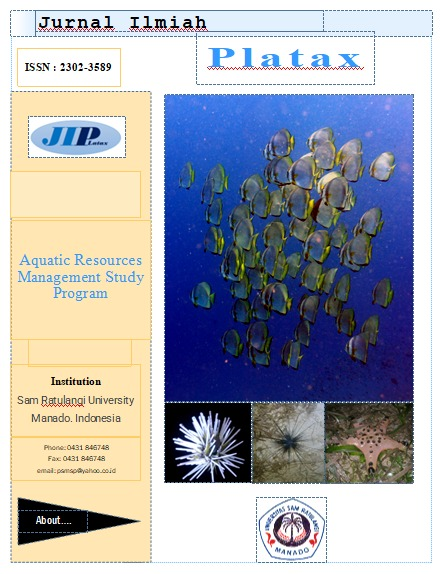Study Of Hard Coral (Scleractinia) Recruitment In The Molas Waters, Manado City
DOI:
https://doi.org/10.35800/jip.v10i1.37489Keywords:
Molas, coral, recruitment, scleractiniaAbstract
Coral recruitment is the entry of new coral individuals into coral reef populations due to reproduction or migration. Juvenile coral is the result of metamorphosis and growth of coral planula measuring 5 cm and attached to certain substrates. There are two types of substrates in the waters, stable substrates and unstable substrates such as rubble. The purpose of this study was to study hard coral recruitment, both in terms of density, the composition of juvenile coral colony types, size, and the type of substrate occupied by juvenile corals. This research was conducted in August 2021 in the waters of Molas, Bunaken District, Manado City. The method used for site selection is the purposive sampling method and data collection using a sampling method with quadrant transects. The results showed that the density of coral recruitment at the study site was 8,43 colonies/m2. The percentage of juvenile coral attachment on stable substrates is 90% and 10% on unstable substrates. The average size of juvenile corals at the study site was 2.4cm. The composition of the juvenile coral genus found at the research site were corals of the genus Acropora, Anacropora, Coeloseris, Cycloseris, Cyphastrea, Echinopora, Favites, Fungia, Galaxea, Goniastrea, Isopora, Leptastrea, Leptoseris, Lobophyllia, Merulina, Montastrea, Montipora, Oulophyllia, Pachyseris, Pavona, Platygyra, Plasiastrea, Pocillopora, Porites, Psammocora, Scolymia, Seriatopora, Symphyllia, and Trachyphyllia. Of the entire genus, corals of the genus Porites were dominated by the number of juveniles as many as 36 colonies.
Keywords: Molas, coral, recruitment, Scleractinia
Abstrak
Rekrutmen karang adalah masuknya individu karang baru pada populasi terumbu karang dikarenakan reproduksi ataupun migrasi. Juvenil karang merupakan bentuk hasil metamorphosis dan pertumbuhan planula karang yang berukuran ≤ 5 cm dan menempel pada substrat tertentu. Terdapat dua tipe substrat di perairan, substrat yang stabil dan substrat yang tidak stabil seperti pecahan karang (rubble). Tujuan penelitian ini adalah untuk mempelajari tentang rekruitmen karang keras, baik dari densitas, komposisi jenis koloni juvenil karang, ukuran, hingga tipe substrat yang ditempati oleh juvenil karang. Penelitian ini dilakukan pada bulan Agustus 2021 di perairan Molas Kecamatan Bunaken Kota Manado. Metode yang digunakan untuk pemilihan lokasi adalah metode purposive sampling dan pengumpulan data menggunakan metode sampling dengan transek kuadran. Hasil penelitian menunjukan bahwa densitas rekruitmen karang pada lokasi penelitian sebesar 8,43 koloni/m2. Persentase penempelan juvenil karang pada substrat stabil sebesar 90% dan pada substrat yang tidak stabil sebesar 10%. Ukuran rata-rata dari juvenil karang pada lokasi penelitian adalah 2,4cm. Komposisi genus juvenil karang yang ditemukan pada lokasi penelitian adalah karang genus Acropora, Anacropora, Coeloseris, Cycloseris, Cyphastrea, Echinopora, Favites, Fungia, Galaxea, Goniastrea, Isopora, Leptastrea, Leptoseris, Lobophyllia, Merulina, Montastrea, Montipora, Oulophyllia, Pachyseris, Pavona, Platygyra, Plasiastrea, Pocillopora, Porites, Psammocora, Scolymia, Seriatopora, Symphyllia, dan Trachyphyllia. Dari keseluruhan genus, didominasi oleh karang genus Porites dengan jumlah juvenil sebanyak 36 koloni.
Kata kunci: Molas, karang, rekrutmen, scleractinia
References
Acosta, A., Luisa, F.D. & Valeria, P. 2011. Review on Hard Coral Recruitmen (Cnidarian: Scleractinian) in Columbia. Universitas Scantiarum. 16:200-208.
Bachtiar, I., M. Abrar., dan A. Budiyanto. 2012. Rekrutmen Karang Scleractinia di Perairan Pulau Lembata. PMIPA, FKIP, Universitras Mataram, Mataram. P3L. P2O LIPI. Ilmu Kelautan UNDIP. Vol. 17 (1) 1-7.
Bauman. A.G., R.G. James., D.Glen., L.Jeffery., A.T Peter. & D.S.Peter. 2015. Coral Settlement on a Highly disturbed equatorial reef system. PLoS ONE 10:1-19.
Engelhardt, U. 2001. Monitoring Protocol for Assessing the Status and Recovery Potential of Scleractinian Coral Communities on Reefs Affected by Major Ecological Disturbances. Reefcare International : Australia.
Karmila., Sadarun, B. & Rahmadani. 2019. Jenis dan Kepadatan Rekrutmen Karang Berdasarkan Bentuk Pertumbuhan Karang Scleractinia di Perairan Lalanu Kabupaten Konawe Sulawesi Tenggara. Jurnal Sapa Laut. 4(3):106 112.
Kusumastuti, A. 2004. Kajian Faktor-Faktor Penyebab Kerusakan Terumbu Karang Di Perairan Bontang Kuala Dan Alternatif Penanggulangannya. Universitas Diponegoro. Semarang. Hal. 34-39.
Manlea, H., Ledheng, L., Sama, Y.M. 2016. Faktor-Faktor Penyebab Kerusakan Ekosistem Terumbu Karang Di Perairan Wini Kelurahan Humusu C Kecamatan Insana Utara Kabupaten Timor Tengar Utara. Jurnal Pendidikan Biologi. Vol. 1, No. 2(21-23).
Nybaken, J.W. 1992. Biologi Laut Suatu Pendekatan Ekologis. Jakarta: PT Gramedia. Pustaka Utama. Jakarta Odum, E.P. 1971. Fundamentals of Ecology. WB Saunders Co: Philadelphia. 574 Hal.
Palupli, R.D., R.M, Siringoringo., & T.A, Hadi. 2012. Status Rekrutmen Karang Scleractinia di Perairan Kendari Sulawesi Tenggara. Ilmu Kelautan, 17(3) : 170-173.
Rizal, S. A. Pratomo. dan H. Irawan. 2016. Tingkat Tutupan Ekosistem Terumbu Karang di Perairan Pulau Terkulai. FIKP-UMRAH.
Roeroe, K.A., M. Yap., dan M. Okamoto. 2009. Development of coastal environment assessment system using coral recruitment. Fish Sci (2009). 75:215-224.
Suharsono, 2008. Jenis-Jenis Karang di Indonesia LIPI Press. Jakarta. 382 Hal.
Suharti, S.R. 2015. Monitoring Kesehatan Terumbu Karang dan Ekosistem Terkait Lainnya. Pusat Penelitian Oseanografi Lembaga Ilmu Pengetahuan Indonesia. Jakarta – 2015.
Wildanun, M. Insafitri. & M. Effendy. 2016. Laju Pertumbuhan Karang Goniastrea sp Pada Kedalaman Yang Berbeda di Pulau Mandangin Kabupaten Sampang. Prosiding Seminar Nasional Kalutan. Universitas Trunojoyo Madura.
Tuhumena, J. R., J. D. Kusen., C. P. Paruntu. 2013. Struktur komunitas karang dan biota asosisasi pada Kawasan terumbu karang di perairan desa malalayang II dan desa mokupa kecamatan tombariri. Jurnal Pesisir dan Laut Tropis. Vol. 3, No. 1, Tahun 2013.
Downloads
Published
How to Cite
Issue
Section
License
COPYRIGHT
Authors who publish with this journal agree to the following terms:
Authors hold their copyright and grant this journal the privilege of first publication, with the work simultaneously licensed under a Creative Commons Attribution License that permits others to impart the work with an acknowledgment of the work's origin and initial publication by this journal.
Authors can enter into separate or additional contractual arrangements for the non-exclusive distribution of the journal's published version of the work (for example, post it to an institutional repository or publish it in a book), with an acknowledgment of its underlying publication in this journal.
Authors are permitted and encouraged to post their work online (for example, in institutional repositories or on their website) as it can lead to productive exchanges, as well as earlier and greater citation of the published work (See The Effect of Open Access).






































